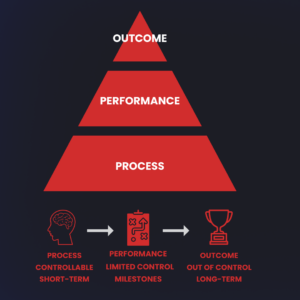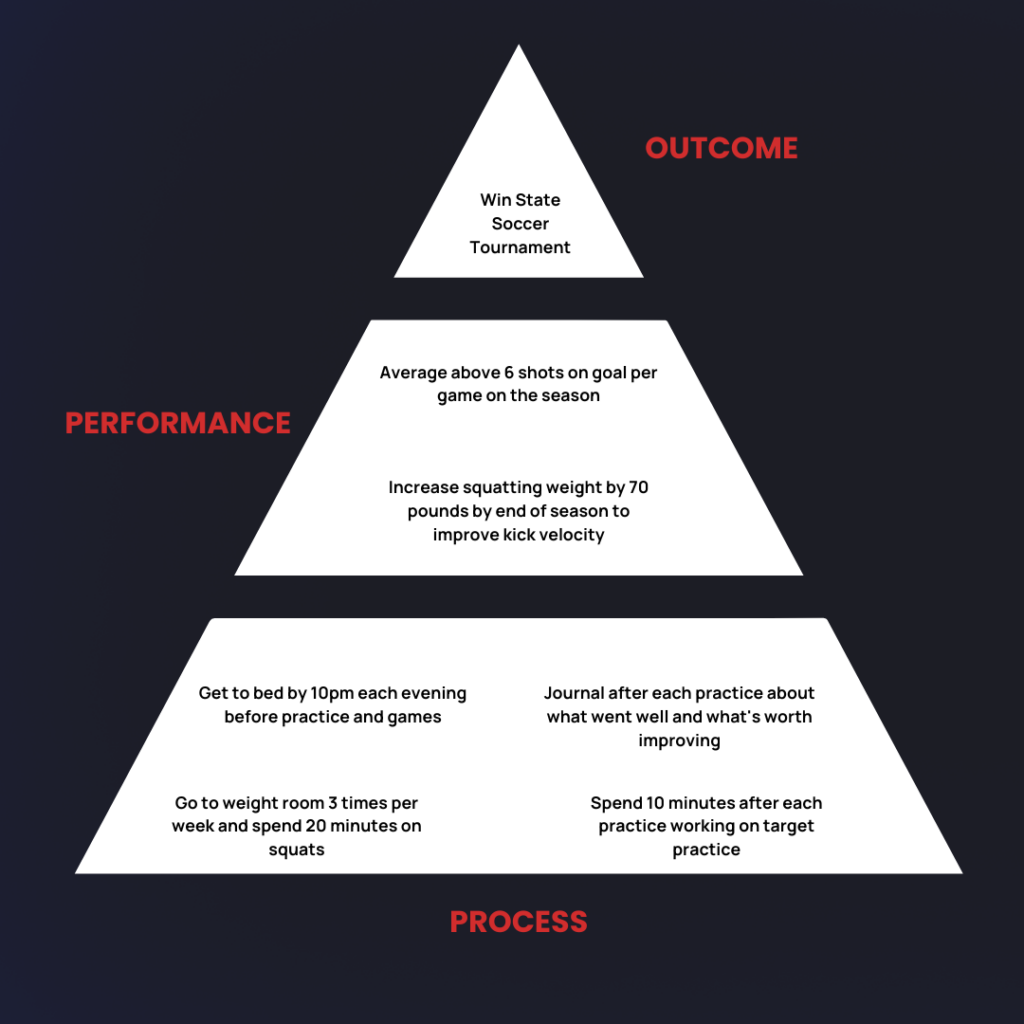How we set goals dictates our approach toward training and competition and can serve as the initial step toward reaching peak performance.
Process vs. Performance vs. Outcome Goals
There are three different types of goals and each type serves a different purpose in getting us where we want to be. It’s important to be intentional about each type of goal, how we set them, and the order in which we view them.
Outcome Goals
Outcome goals are what get us up in the morning and keep us going. Think of outcome goals as big picture goals; winning the state tournament, making the varsity team, or getting a division one offer to your dream school. Yet while outcome goals are exciting, they are almost always out of our control.
You could play the best tennis match of your life the day of the state championship but there’s still a chance that your opponent could play better, or that weather could impact play. That doesn’t mean you shouldn’t set outcome goals. Yet it’s important to be aware that there are contributing factors outside of your control. To give yourself the best chance of achieving your outcome goals, focus on performance goals and day-to-day process goals.
Tip: Accomplishing outcome goals take the most work and are long-term. To maximize goal attainment, limit yourself to 1-2 outcome goals at a time.
Performance Goals
Achieving outcome goals doesn’t happen without first achieving performance goals. These goals pertain to things that can be attained through hard work and incremental improvement. For example, if your outcome goal is to make the all-state football team, accomplishing a performance goal such as averaging over two touchdown passes per game on the season can help you get there.
There are things within performance goals that are within our control; a quarterback can control the focus they bring into each game, their pre-game routine, and their daily workout regimen that will naturally put them in a better position to succeed. Yet there are still things within performance goals that are uncontrollable; a quarterback could be throwing the ball better than ever before in a game but receivers could struggle to get open. The weather could impede on the quarterback’s ability to scramble in the pocket and the opponent’s defensive line could be having their best game of the year.
Performance goals serve as a vehicle to reach our outcome goals, yet do not take place without first mastering process goals.
Process Goals
To achieve performance goals and outcome goals, an athlete must first achieve process goals. Process goals are day-to-day frequent goals within our control that will put us in the best position to achieve performance and outcome goals. Things like drinking enough water each day, working out three times a week, and journaling after each practice and competition are all process goals. Process goals seem small but lay the foundation for us to reach success and notice growth.
Since they are within our control, process goals allow us to notice progress, even if we fall short in our performance or outcome goals. Let’s say a volleyball player’s process goals include drinking eight glasses of water a day and utilizing a new breathing technique in pressure situations and has a performance goal of making 85% of serves in a week and an outcome goal of being selected as Senior Athlete of the Year. Even if uncontrollable factors prevent the latter two goals from happening, the athlete will still notice growth from the controllable process goals that she has set. Focusing on things within our control is not only the foundation of success in life, but the base layer of effective goal-setting.
Did You Know? Research shows that process goals are the most important goals for athletes to make!
Action: Create a Goal Pyramid
It’s important to identify your process, performance, and outcome goals. Create a pyramid and place your outcome goals at the top, performance goals in the middle, and the process goals required to get there at the bottom. It’s important to be intentional when goal-setting and not biting off more than you can chew. Note the shape of the pyramid below. As a rule, we should have more process goals than performance goals and more performance goals than outcome goals. As we move up the pyramid our goals become less in our control. When lacking motivation, remind yourself that small process goals are leading you in the right direction, even if it doesn’t feel like it in the moment. Use the pyramid to check in with your goals and adapt when needed.

Example
